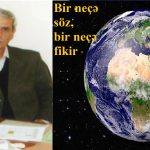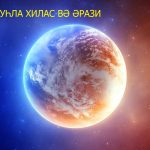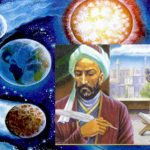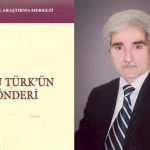Meteorological and Cultural Influence of the Deluge on Nakhchivan
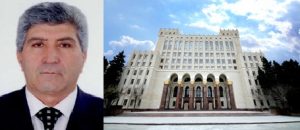
Since earliest times, as a result of struggle of the primitive people against natural forces, various myths and legends had appeared, and religions and in the sequel different philosophic currents had been developed. Though many legends had real roots, during centuries human imagination rendered them fantastic.
Owing to these causes researches for determining, if those myths and legends created by human mind have real roots, stay as a significant problem before the society at the present development stage of the civilization. In other hand, the earthquakes, storms and floods occurring frequently on the earth make again actual research of the reasons of appearance of these legends.
One of the legends engraved in human memory for thousands of years, showing his helplessness towards the nature and divine forces, is the legend about Noah’s storm. In scientific literature this event is mostly mentioned as “The Deluge”, that is related with its reference to Bible variant. The fact that the legend about the Deluge – the Noah’s storm is widespread among different nations in the different places of the Earth, that in different religious doctrines it is considered as a real fact, and even it is shown that spreading of the contemporary nations on the earth is directly related with this legend, conditioned its constant stay on the focus of scientific community. We should note that there are also the scientists who adduce the opinion alleging that the legend about the Deluge was created as a result of giving mythic character to the terrible historical events (1, p. 78-79). According to their opinion the legend about deluge, which appeared at the period of dynasty of Ur III afterwards prevailed in ideology of Babylon and Assyria. According to this mythology, the deluge is related with myth on God’s punishment and attack of enemies. In the mythic written text “Akkad’s Damnation” the deluge implies attack and stream of kutis, which continued during 7 days and 7 nights. After Ur’s collapse there were made changes in the deluge ideology as well (1, p. 78-79).
The most ancient variant of the legend about Noah’s storm is Sumerian variant published by archeologist Arno Poebel in the XIX century. Here God of Enki informs the king Ziusudra about coming deluge on the wall of his house. As well as in the Babylon variant of the legend God of Ninnihiku-Ea informs Utnapishtim about due disaster on the wall of his hut. Many researchers note that this fact of “informing” was the result of weak earthquake. Finally, in the Bible and Qur’an this disaster is elucidated as God’s punishment sent on people as a result of his rage. We should note that in all above mentioned variants the disaster is described in approximately similar manner: pouring rains continuing uninterruptedly during 40 days and 40 nights accompanied by strong southern wind. According to above stated we may come to such a conclusion that in ancient Sumerian and Babylon variants of the legend, in the Bible and Qur’an it is informed of the natural disaster that happened in extreme antiquity. Though countless number of works were written about the Deluge during recent 200 years, its date has not been completely specified yet.
According to common conclusion of geologists, archeologists and historians the most terrible worldwide deluge occurred between the XII-IX millenniums B.C. But it is also indicated that the Deluge related with Noah happened between the Tigris and Euphrates Rivers 5-6 thousand years ago (2, p. 19-29). If to take into consideration that this terrible event spread to the distance much more further than it happened, and it was reflected in ancient written sources and in religious books, we will see that revelation of its date, place of occurrence and scale have great significance. Probably, the Deluge that we are speaking about was the last largest deluge in history of mankind that was recorded. The floods which happened after that were of smaller scale and could not provoke great resonance in the ancient world. The flood related to Prometheus’ son Deucalion, which according to supposition of Greece historians happened in 1550 B.C., may be considered one of the local natural disasters as well.
Geologists and archeologists have already proved by their scientific researches that the worldwide Deluge related with Noah really happened. But existence of very big difference between the territory where the flood occurred (between the Tigris and Euphrates Rivers) and the territory where the legend spread has objective reasons.
Scientific community changed its attitude towards the legend about Noah’s deluge after revelation of traces of the deluge with thickness of 3.5 m by English archeologist Leonard Woolley during excavations of ancient Ur city in 1929. But as the traces revealed by L.Woolley were located on very ancient cultural layer, naturally, it indicated antiquity of the deluge as well. The layer of clay with admixture of sand revealed afterwards during archeological excavations carried out around ancient city of Shuruppak and in the place of the city of Kish, was located on the cultural layer dating from the beginning of the III millennium B.C. Just this date conformed more to the date of the deluge related with Noah. Therefore, the fact that Noah’s Deluge happened between 3100-2900 B.C. is accepted most of all. But, taking into consideration that strong influence of the culture of Mesopotamia was revealed in many monuments of the Copper Age of the Southern Caucasus, and even it was created on the ground of the ethnic migration, we can agree with probability that these terrible accident happened more anciently, maybe in the end of the Copper Age.
We are mostly interested just in Nakhchivan variant of the legend about Noah’s storm. We should firstly note that this variant is not still known to European scientists, and they have not referred and are not referring on it in their researches. Nevertheless, we can say with conviction that the Nakhchivan variant has more advantages than other variants, and it should be emphasized especially.
According to the Nakhchivan variant of the legend about Noah’s storm, as a result of long-lasting storm and pouring rain the all places become flooded. Just tops of the highest mountains were on sight. After the storm stopped Noah’s ark looking for a place to moor approached to a high mountain. Bold cliffs, snow, ice did not allow the ark to stop. Because of facing here a lot of torments, since then that mountain was called “Aghri daghi” (“Mountain of Torment”). The ark floated from “Aghri” mountain to the east to moor to another mountain, but in spite of a lot of efforts it could not moor here too, and he said “this mountain is as inferior as another one” (Inferior, bad – /Kəm/). And since then this mountain was called “Kamki daghi” (“Inferior Mountain”). Noah’s ark floated from that place towards higher mountains. In one place the bottom of the ark got stick to the top of a mountain remaining under the water, and the ark stopped. After getting out of there with difficulty Noah said: “Believe me (inan ki) that it is a mountain”. According to sayings, that mountain was “Ilanli dagh”. Even it is said that Noah’s ark had split the top of “Ilanli” mountain into two parts. That is why “Ilanli” mountain is also called by population as “Hacha dagh” (“Forked Mountain”).
The ark moved away from that place, and stopped in a favorable place on the foot of a high mountain. At that time water level had been already lowering too. The place where Noah’s ark stopped was the mountain near Nasirvaz village, which was called since then “Gami gaya” (“Ark Rock”). It is said that the remnants of the ark have been still remaining on that mountain by now. Now Gamigaya is known in science with its rock painting dated from the Bronze Age.
After the ark moored, Prophet Noah together with his children set villages on the foot of Nakhchivan mountains, on the banks of rivers. The present population of Nakhchivan are Noah’s descendants, who had settled down there since then. Prophet Noah most of all liked the place of junction of the Nakhchivan river with the Araz river. He set the village and started living there. His grave is in Nakhchivan too (in the place called “Nuh daban” (“Noah’s Heel”)). It is also provokes interest that the word “Nasir” (/Nəsir /) in the name of the village of Nasirvaz (/Nəsirvaz/) resembles the name of “Nisir” mountain in Sumerian variant of the legend.
As we see from the legend, the names of four big mountains in Nakhchivan and in its surrounding territory are related with Prophet Noah’s name.
Some nations relate dissemination of the legend about Noah’s ark among Muslim countries just with Qur’ani-Kerim. It is possible that many Muslim nations learned about this legend from Qur’ani-Kerim. But as we learned above, Nakhchivan variant of the legend thoroughly differs from its variant in Qur’ani-Kerim, and it has precise local characteristics.
It is much interesting when and how this legend appeared being saved in memory of old tribes of Nakhchivan during millenniums. Generally, we already know that the worldwide deluge happened between the Tigris and Euphrates Rivers (in Mesopotamia). Then it may be asked, what relation does the legend have with Araz territory, especially with Nakhchivan region? If to look through map, you will see that the Tigris and Euphrates Rivers are not so far from the Araz River geographically. In other words, the natural disaster shown in the legend could have direct relation with Nakhchivan. If to pay attention, in Nakhchivan variant of the legend the natural disaster called not the deluge, but storm. By our opinion, when Noah’s storm happened powerful meteorological changes occurred not only in Mesopotamia, but also in close regions, especially in mountain territories. In Nakhchivan territory there took place pouring rains accompanied with destructive wind (storm). The reason of this was a lot of water evaporation and powerful winds in Persian Gulf accompanied with volcanic eruption in the seabed. Probably, as a result of powerful winds the clouds passing in the south of Zagros Mountains created long-lasting terrible rains in the region of Zangazur and Garadagh chains of the Small Caucasus. There were unbelievable floods. The traces of these floods can be obviously identified in Nakhchivan territory, on the southern foots of Zangazur chain. Therefore, the natural disaster which we call Noah’s storm influenced Nakhchivan territory as well. This incident that left deep traces in ancient people’s memory was the reason of appearance of Nakhchivan variant of the legend.
Secondly, part of the population terrified as a result of the natural disaster that happened in Mesopotamia (between the Tigris and Euphrates Rivers) could move far from there and settle in other places. Naturally, people escaping from the disaster coming from sea found their rescue on the mountains, migrated to north-east parts of Asia Minor and to the Southern Caucasus territories (4, p. 154). Probably, some of them moved to Nakhchivan territory and settled there. Therefore, the legend about Noah’s ark could appear in Nakhchivan this way too. It is known about relation of Nakhchivan territory with the ancient civilization centers in the Bronze Age. According to assumption of V.Aliyev, corresponding member of the National Academy of Sciences of Azerbaijan, the cities already existed in Nakhchivan in the Bronze Age. Maybe one of the reasons of formation of the cities in Nakhchivan, which was situated far from the cultural center of the ancient world, was migration of the part of population from Mesopotamia during Noah’s storm. Cultural influence of Mesopotamia is observed more obviously in the monuments of Nakhchivan of the Early and Middle Bronze Age, especially in ceramics and decorations (4, p. 3; 5, p. 9,187,190; 6, p. 86-93).
Speaking of Nakhchivan variant of the legend about Noah’s ark we should note especially one matter. This legend saved in memory of Nakhchivan Turks during centuries was spread among Armenians during resent middle ages, and thus “Armenian variant” of the legend appeared as well. We should firstly note that just one fourth part of Nakhchivan variant was attracted in Armenian variant. In Armenian variant of the legend about Noah’s ark, after the ark stopped on Ararat (Aghri) mountain, Prophet Noah chose Nakhchivan as his habitation area. And the name of Nakhchivan appeared since then. As if Nakh (/Nax/) means “the first” and ichevan (/içevan/) – station. We give records of Malkhasyants, who translated “Bishop Sebeos’ History” (Erevan, 1939) as is: “…Нахчеван или Нахчаван – главный город кантона того же имени Васпураканской провинции на реке Аракс. Слово Нахчаван по составу означает местечко Нахч-a (или Нахуча, Нахича) как Эрвандаван, Вагаршаван и пр. Но в XVIII в. армянские грамотеи его истолковали иначе: Нахичеван – первая стоянка, в связи с преданием, будто Ноев Ковчег остановился на горе Арарат и Ной, сойдя с горы, тут, на месте этого города строил свою первую стоянку. На основании этой наивной этимологизации с тех пор название этого города стали писать Нахичевань» (7. прим. 90).
“Nakhchevan or Nakhchavan is the main city of the canton of the similiar name of Vaspurakan (it is called Basfurracan in Arabic sources – B.İ.) province on the river of Araks. The word Наkhchavan by its structure means the place of Nakhch (or Nakhuch, Nakhich) as Ervandavan, Vagarshavan and etc. But in XVIII century Armenian wiseacres interpreted it otherwise: Nakhichevan – the first station, in connection with the legend as if Noah’s Ark stopped on Ararat (Aghri – B.I.) mountain and Noah getting down from the mountain settled his first habitation station in the place of this city. On the ground of this naive etymology, since then the name of this city was written as Nakhichevan.
I.Chopin’s opinion about the way of creation of Armenian variant of the legend about Noah’s storm is also interesting (“Исторический памятник состояния Армянской области в эпоху присоединения к Российской империи” С.П. – 1852 г.).
He writes of relation of Nakhchivan city with Noah, basing on ancient Jewish historian Joseph Fluffy (37-100). At the same time I.Chopin states that the fact of location of Noah’s grave in Nakhchivan was recorded for the first time by Armenian geographer Vartan. He notes that there is not only Noah’s grave, but also his sister’s grave in Nakhchivan. But the author asks to himself that “it is a wonder, why Armenian authors who lived before Vartan, especially Moses Khorenasy, who is called “the father of Armenian history” had not written a word about it? According to I.Chopin, the legend of Noah passed to Armenians from Medians. As if those Medians were those who had been captured by Tigran I (565-520 b.c.) after Astiag’s death together with his family, and they had been transmigrated to present Nakhchivan territory. We may suppose that Midian lived in Nakhchivan territory and Armenians adopted the legend about Noah’s storm from them. But it is unbelievable that those Medians were transmigrated here by Tigran I. Because, there is not any information about it in other historical source other than Moses Khorenasy. In other hand, Armenians transmigrated in Nakhchivan territory in the XVII and XIX centuries could just hear this legend from residents and misappropriate it. Our neighbors have misappropriated not only our legends and myths, but also most of achievements of our moral culture. A number of thievish elements being ignorant in science, who have not stopped encroaching on our lands, are trying to use the legend about Noah’s storm for their slovenly aims. They also tried to organize periodical visit of Christian religious figures and religious people to Nakhchivan, to make Gamigaya a temple having put here Noah’s monument, and to plan their periodical visit here. It is good that this ridiculous and, at the same time, dangerous plan failed as a result of efforts of our national spirited intellectuals, of the government of Autonomous Republic and of the appropriate state bodies. We scientists have to research again existence of real historical roots of “The Legend about Noah’s Storm”, prevent appropriation of moral wealth of our nation by strangers or not allow the strangers in science to turn them into a cheap show.
Bahlul Ibrahimli,
Candidate of History,
Leading scientist of the Archeology and Ethnography Institute
of the National Academy of Science of Azerbaijan
Translated by Kamala Amiraslanova
From the book “Elman Aliyev: As Is and Seems”
Baku, “Nargiz” publishing house, 2012, p.183-190


